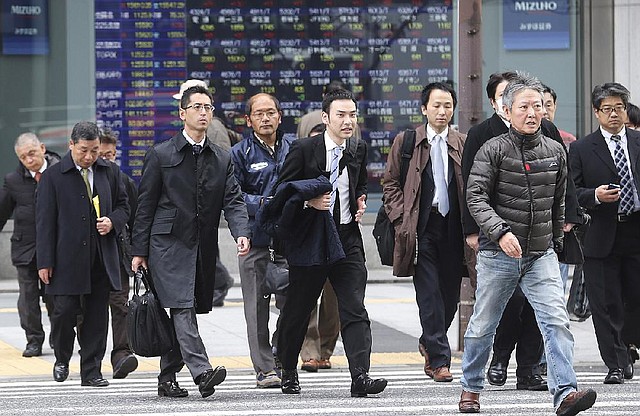Japanese see boom in projects as deja vu
People walk by an electronic stock board of a securities firm in Tokyo, Monday, Dec. 9, 2013. Japan has revised its economic growth estimate for the last quarter downward after finding that capital investment slowed more than expected in July-September. (AP Photo/Koji Sasahara)
Tuesday, December 10, 2013
SAGA, Japan - The bulldozers started up with a rumble this year in this bucolic corner of southern Japan, unleashing a construction frenzy - and a sinking feeling of deja vu.
The traffic cones and “under construction” signs alongside Saga’s roads and waterways are about the only visible change brought about by “Abenomics,” Prime Minister Shinzo Abe’s plan to put Japan back on the path to growth. Residents here say the building boom is a throwback to Japan’s troubled 1990s, when the country tried to build its way back to prosperity.
And they worry that, like previous attempts, growth will not last.
“How long before all this winds down again? That’s what everyone’s worried about,” said Masataka Matsuo, a construction worker reinforcing an irrigation ditch several miles away from the city center.
Japan has been the world’s surprising growth story this year, largely outpacing other major industrialized countries with a set of policies that are lifting its economy after years of deflation. So far, it has been Abe’s bid to pump the nation’s banks with money - together with his promises of wide-ranging market changes - that have garnered much of the investor spotlight.
But some economists say that Japan’s recovery has become dependent on largescale public works spending, remembered here for adding to Japan’s debt burden, fueling pork-barrel politics and riddling the country with little-used roads, bridges and dams.
On Thursday, the government announced new stimulus spending of $53 billion, much of it for public works, in a bid to offset any negative public reaction to a coming increase in a national sales tax.
Spending on infrastructure projects will do little to lift Japan’s growth potential in the long term, some economists warn. And with limited evidence that monetary easing is in fact lifting the real economy, growth “risks falling off a cliff ” when government outlays sputter, said Chotaro Morita, chief strategist at SMBC Nikko Securities in Tokyo.
“Japan’s growth engine has been massive government spending,” Ryutaro Kono, economist for BNP Paribas, said in a recent note.
Saga, a small prefecture of about 850,000 people, knows all about government largess. Construction was abundant here during the 1990s, as Japan sought to fend off a recession with a huge public works drive that in some years topped the entire military budget of the United States.
Saga built a new airport, dammed nearly all its river systems and opened a 200-acre landscaped park with a visitor center and almost 100 historical buildings. At the peak of the building frenzy, one in nine workers in Saga worked in construction.
But from the early 2000s, a reformist prime minister started to reduce spending, leaving regions such as Sagain the lurch. The Democratic Party, which took the country’s helm in 2009, declared that Japan would further shift its resources “from concrete to people.” By 2012, public investment had declined to one-third of its peak in 1998. Almost one-fifth of Saga’s construction companies closed or went out of business. The local economy plummeted.
Abe, who led the Liberal Democratic Party to victory last December, has again turned on the spigot. Barely two weeks after he took office, Abe announced more than $110 billion for an emergency stimulus package centered on public works.
Within days, Saga’s prefectural assembly passed a $271 million stimulus package of its own, four-fifths of which went to infrastructure projects. The runway at Saga’s airport must be repaved, lawmakers said, and roads extended. The prefecture even began to upgrade its Japanese-style public toilets to Western-style ones.
With no guarantee the spending bonanza will continue, even construction companies are hesitant to ramp up hiring or investment. A growing number of public construction projects are finding no bidders because of a shortage of workers and machinery.
“There’s lots of work, but it’s too risky to start expanding again. Government is so fickle,” said Tsuyoshi Kishimoto, president of Kishimoto Gumi, one of Saga’s biggest contractors.
This fiscal wheel-spinning would not be as much a concern if the other Abenomics policies were wielding a wider effect. But here in Saga, there are few signs the easy money is being put to good use. Lending at the Bank of Saga, the region’s biggest lender, “has been largely flat this year” with little signs of a pickup in demand for funds, said Takanori Nishikubo, a bank spokesman.
Nor are consumers here starting to spend, and for good reason. Saga’s ratio of job offers to job-seekers, a crucial employment measure, continued to stagnate at 0.77 in September. An almost 20 percent jump in construction jobs was not enough to offset a loss of jobs in other sectors, according to the local government. With a tepid labor market, wages have also remained stagnant, as have consumer prices, because of weak demand, according to a November report released by the Fukuoka branch of the Bank of Japan.
Business, Pages 23 on 12/10/2013
